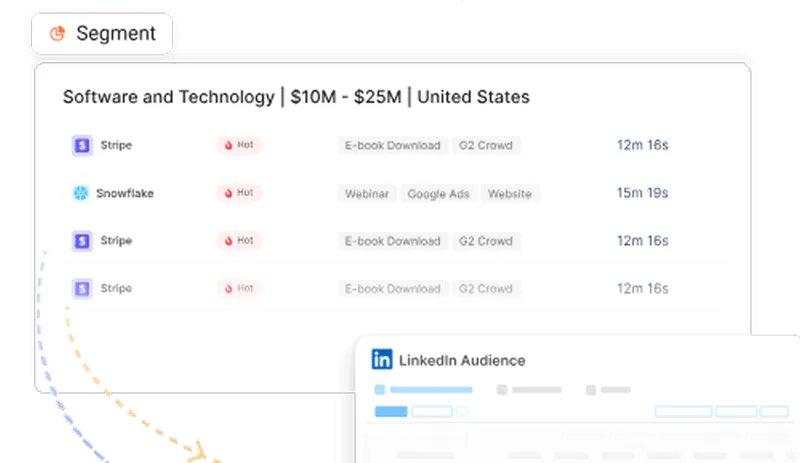Lead Generation 101
Explore how Factors enhances lead generation with AI insights, customer journey analytics, and campaign optimization.
Lead generation and lead prospecting are foundational aspects of a successful business strategy. They are the processes through which businesses identify potential customers and engage them to convert them into loyal clients. The importance of these processes cannot be overstated, as they directly impact revenue growth, customer acquisition, and overall business success.
Over time, lead generation and prospecting have evolved significantly. With advancements in technology and data analytics, businesses now have more sophisticated tools at their disposal to identify, engage, and convert leads. However, despite these advancements, the fundamental principles of lead generation and prospecting remain the same: understanding your audience, engaging them effectively, and nurturing them through the buyer's journey.
TL;DR
- Key Strategies:
- Generate Leads: Use content, SEO, social media, email, webinars, and PPC.
- Prospect Leads: Research and engage leads through outreach methods.
- Challenges & Solutions:
- Quality Leads: Use detailed buyer personas and personalized content.
- Data: Enrich lead info for better insights.
- Automation: Balance with personal touch.
- Follow-Ups: Use CRM tools for efficient management.
- Best Practices:
- Create detailed buyer personas.
- Use data analytics for insights.
- Optimize your website with clear CTAs.
- Implement lead scoring.
- Nurture leads with targeted content.
- Combine automation with personalization.
- Continuously test and optimize strategies.
But First Things First - Let’s Understand Lead Generation
Lead generation attracts and converts strangers and prospects into customers who have expressed interest in your company's product or service. It is an essential part of the sales funnel, laying the foundation for all subsequent sales and marketing efforts.
Lead Generation Process
The lead generation typically begins with attracting visitors to your website or business through various marketing strategies. These strategies may include content, social media, email, and SEO. Once these visitors are on your site, the next step is to convert them into leads by collecting their contact information, usually through a form or landing page.
A lead is an individual or organization that shows interest in your product or service in some way. Typically, a lead provides their contact information in exchange for something of value, such as an eBook, a free trial, a webinar, or other educational content. This is where the lead generation process transitions into lead nurturing, aiming to move the lead down the sales funnel toward a purchase decision.
Also Read: Lead Generation vs. Demand Generation
Key Lead Generation Strategies
- Content Marketing:
According to the Content Marketing Institute, 70% of B2B marketers create more content than one year ago, highlighting its importance in attracting and engaging potential leads. The key is to produce content that resonates with your audience’s needs and interests and offers solutions to their problems.

- Search Engine Optimization (SEO):
SEO is optimizing your website and content to rank higher in search engine results pages. The higher your ranking is, the more visibility and organic traffic you get. An effective SEO strategy involves keyword research, on-page optimization, and building quality backlinks. According to a study by BrightEdge, organic search drives 53% of all website traffic, making it a critical component of lead generation.
- Social Media Marketing:
Social media platforms like LinkedIn, Twitter, and Facebook offer powerful tools for lead generation. Businesses can attract potential leads by sharing valuable content and engaging with followers. In fact, LinkedIn is 277% more effective for lead generation than Facebook or Twitter.
- Email Marketing:
Email marketing remains one of the most effective lead-generation strategies. By offering valuable content in exchange for email addresses, businesses can build a list of leads to nurture over time.
Did you know?
Email marketing has an average return on investment (ROI) of $42 for every $1 spent, demonstrating its effectiveness in lead generation.
- Webinars and Virtual Events:
Hosting webinars and virtual events can be an excellent way to generate leads. These events allow businesses to showcase their expertise, build relationships with potential customers, and collect valuable lead information during registration. Believe us when we tell you that 73% of B2B marketers and sales leaders say a webinar is the best way to generate high-quality leads!
- Pay-Per-Click (PPC) Advertising:
PPC advertising, particularly on platforms like Google Ads, can drive targeted traffic to your website. By bidding on specific keywords, businesses can ensure their ads appear when potential leads search for related products or services. Although PPC requires a financial investment, it can yield immediate results, making it a valuable tool in the lead generation arsenal.
What is Lead Prospecting?
Once leads are generated, the next critical step is lead prospecting. While lead generation focuses on attracting leads, lead prospecting is about actively reaching out to those leads to qualify them and move them down the sales funnel.
Lead prospecting involves identifying potential leads, researching them, and initiating contact through various outreach methods. The goal is to engage these leads, assess their needs, and determine their potential to become paying customers.
Also, read more about lead enrichment in B2B.
The Difference Between Lead Generation and Lead Prospecting

While lead generation and lead prospecting are closely related, they serve different purposes within the sales funnel:
- Lead Generation
Focuses on attracting potential customers through inbound marketing strategies, such as content marketing, SEO, and social media marketing. The goal is to generate interest and capture contact information.
- Lead Prospecting
Involves actively searching for potential customers through outbound activities, such as cold calling, emailing, and networking. The goal is to identify and engage with leads, qualifying them for further sales efforts.
Challenges in Lead Generation and Lead Prospecting
Despite the importance of lead generation and prospecting, both processes have their own set of challenges. Understanding and addressing these challenges is crucial for optimizing sales and marketing efforts.
1. Generating High-Quality Leads
One of the most significant challenges in lead generation is attracting interested leads who are likely to convert into paying customers. This challenge often arises from a need for more understanding of the target audience. Detailed buyer personas can help tailor marketing efforts to attract the right leads. Additionally, focusing on quality over quantity in content marketing and SEO efforts can help attract more relevant leads.
2. Insufficient Information For Prospecting
For lead prospecting, a significant challenge is often the lack of detailed information about the lead before making contact. This can make outreach efforts feel generic and less effective. Businesses can use data enrichment tools to gather more information about leads before initiating contact to address this challenge. These tools can provide valuable insights into a lead’s company, job role, industry, and recent activities, allowing for more personalized and effective outreach.
3. Balancing Automation with Personalization
Automation tools have made it easier to scale lead generation and prospecting efforts. However, over-reliance on automation can make interactions feel impersonal, which can turn potential leads away. Striking the right balance between automation and personalization is crucial. For example, while automated emails can help maintain contact with a large number of leads, they should be personalized to address the specific needs and interests of the recipient.
4. Follow-Up Fatigue
Following up is critical in lead prospecting, with research showing that 80% of sales require five follow-ups after the initial contact. However, managing multiple follow-ups can be exhausting and time-consuming for sales teams, especially when dealing with many leads. CRM systems can help automate follow-up reminders and track interactions to ensure no lead falls through the cracks.
Tips for Lead Generation and Lead Prospecting
It's important to follow best practices to overcome these challenges and optimize your lead generation and prospecting efforts. These practices can help you attract more high-quality leads, engage your leads more effectively, and ultimately close more deals.
1. Build Detailed Buyer Personas
Creating comprehensive buyer personas is crucial for both lead generation and prospecting. These personas help you understand your audience’s pain points, goals, and decision-making processes, allowing you to tailor your content and outreach strategies effectively.
When developing buyer personas, consider demographic information, job roles, challenges, and buying behaviors. This information can be gathered through customer surveys, interviews, and CRM data analysis. The more detailed and accurate your buyer personas, the more targeted and effective your lead generation and prospecting efforts will be.
2. Leverage Data and Analytics
Data-driven strategies are essential for optimizing lead generation and prospecting. By leveraging data and analytics, you can gain valuable insights into your audience’s behavior, preferences, and engagement with your brand. Tools like Google Analytics, CRM systems, and marketing automation platforms provide a wealth of data that can be used to refine your strategies.
For lead generation, analytics can help you understand which content and channels drive the most traffic and conversions. For prospecting, data can be used to identify the most promising leads, track engagement, and personalize outreach efforts.
3. Optimize Your Website for Lead Generation
Your website is often the first point of contact for potential leads, making it a critical component of your lead generation strategy. To maximize lead generation, your website should be optimized to capture visitor information and convert it into leads.
This involves using clear and compelling calls-to-action (CTAs), offering valuable content in exchange for contact information, and ensuring that your forms are user-friendly. Additionally, your website should be mobile-friendly and optimized for speed, as these factors can significantly impact user experience and conversion rates.
4. Implement Lead Scoring
Lead scoring is a powerful tool for prioritizing leads and focusing your sales efforts on the most promising prospects. By assigning a numerical value to each lead based on engagement and behavior, you can identify which leads are most likely to convert. Factors influencing lead scores include website visits, content downloads, email opens, and social media interactions.
5. Nurture Leads with Targeted Content
Lead nurturing is developing relationships with your leads through targeted and personalized content. This is particularly important for leads who are not yet ready to purchase. By providing valuable information and addressing their pain points, you can guide them through the buyer’s journey and move them closer to a purchase decision. Email marketing is one of the most effective lead-nurturing strategies. You can send personalized content that resonates with each lead by segmenting your email list based on lead behavior and interests.
6. Use Automation Wisely
Marketing automation tools can streamline lead generation and prospecting efforts, allowing you to manage large volumes of leads more efficiently. Automation can be used for email marketing, social media scheduling, lead scoring, and CRM management. However, using automation wisely is important to avoid making interactions feel impersonal.
To maintain a personal touch, use automation to handle repetitive tasks, such as sending follow-up emails or scheduling social media posts, while still personalizing your messages based on lead data. By combining automation with personalization, you can scale your efforts without sacrificing the quality of your interactions.
For example, SendPulse offers their chatbots in combination with the live chat function so that a human can take over the conversation and help with customer queries.
7. Continuously Test and Optimize
Lead generation and prospecting strategies should be continuously tested and optimized for better results. A/B testing, in particular, is a valuable method for identifying what works and what doesn’t. You can determine which elements drive the most engagement and conversions by testing different versions of your CTAs, landing pages, emails, and content.

Here’s What The Future of Lead Generation and Prospecting Looks Like
As technology evolves, so do the methods and tools used for lead generation and prospecting. Emerging trends such as artificial intelligence (AI), machine learning, and predictive analytics are set to revolutionize these processes, making them more efficient and effective.
AI and Machine Learning
AI and machine learning are already used to enhance lead generation and prospecting. These technologies can analyze vast amounts of data to identify patterns and predict which leads will most likely convert. AI-powered chatbots, for example, can engage with website visitors in real-time, answering questions and capturing lead information even when sales teams are unavailable.
Machine learning algorithms can also improve lead scoring by continuously learning from past interactions and refining the scoring model to be more accurate. As these technologies advance, they will be increasingly important in automating and optimizing lead generation and prospecting efforts.
Predictive Analytics
Predictive analytics involves using historical data and statistical models to predict future outcomes. In lead generation and prospecting, predictive analytics can be used to forecast which leads are most likely to convert and when they are likely to do so. This allows sales teams to prioritize their efforts and focus on the most promising leads at the right time. As predictive analytics tools become more accessible, they will become a standard part of the lead generation and prospecting toolkit.
Account-Based Marketing (ABM)
Account-based marketing (ABM) is a targeted approach to lead generation and prospecting that focuses on key accounts rather than individual leads. ABM involves identifying high-value accounts and creating personalized marketing campaigns specifically for those accounts. This approach is efficient for B2B companies with complex sales cycles and high-value customers. As businesses adopt ABM, it will become an essential strategy for generating and nurturing high-quality leads.
How Factors Can Help
Factors is an advanced marketing analytics platform designed to help businesses gain deeper insights into their marketing efforts, particularly in understanding customer journeys and optimizing campaign performance. Here’s how Factors can specifically support your lead generation and prospecting strategies:
- Customer Journey Analytics
Factors excels in providing detailed customer journey analytics. By tracking interactions across multiple touchpoints, the platform helps businesses understand the path a prospect takes before converting. This insight allows you to tailor your marketing and sales strategies to meet prospects at the right stage in their journey, ultimately increasing conversion rates.
- Multi-Touch Attribution
One of Factors's standout features is its multi-touch attribution capabilities. This feature enables businesses to credit various marketing activities that contribute to a conversion. By understanding which channels and tactics are most effective at different stages of the customer journey, you can optimize your marketing spend and focus on the efforts that yield the highest return on investment (ROI).
- Campaign Performance Insights
Factors provides in-depth insights into campaign performance, helping marketers identify which campaigns drive results and which need adjustment. The platform’s analytics tools allow you to monitor key metrics, understand the impact of your marketing strategies, and make data-driven decisions to improve overall campaign effectiveness.
- Customizable Dashboards
The platform offers customizable dashboards, which allow users to create views that align with their specific business goals. Whether you want to focus on tracking the performance of specific campaigns or monitoring the overall health of your marketing funnel, Factors’s dashboards provide the flexibility to visualize the data that matters most to you.
- Integration Capabilities
Factors supports integration with various CRM and marketing tools, allowing for seamless data synchronization across platforms. This ensures that all your marketing and sales data is unified, enabling better collaboration and more informed decision-making.
- AI-Driven Insights
The platform leverages AI to analyze customer behavior and provide actionable insights. By identifying patterns and trends in your data, Factors helps you uncover opportunities to optimize your marketing strategies, improve lead quality, and enhance overall business outcomes.
Lead generation fuels business growth by attracting and converting qualified prospects.
1. Core Strategies: Content marketing, SEO, social media engagement, and lead magnets.
2. Audience Focus: Tailor efforts to target needs and deliver real value.
3. Strategic Benefits: Build a strong sales pipeline, improve conversion rates, and drive sustained growth.
A well-executed lead generation strategy lays the foundation for long-term customer acquisition success.
In a Nutshell
Lead generation and lead prospecting are critical components of a successful sales strategy. While lead generation focuses on attracting potential customers through inbound marketing, lead prospecting involves actively reaching out to those leads to qualify them and move them through the sales funnel. Both processes are essential for building a pipeline of high-quality leads that can be converted into loyal customers.
Businesses can optimize their lead generation and prospecting efforts by implementing best practices such as building detailed buyer personas, leveraging data and analytics, optimizing their website, and using automation wisely. Factors is a powerful tool for businesses looking to enhance their lead generation and prospecting efforts through better data analysis and insight generation. The platform provides the tools necessary to optimize marketing strategies and drive better results by focusing on customer journey analytics, multi-touch attribution, and campaign performance.
See how Factors can 2x your ROI
Boost your LinkedIn ROI in no time using data-driven insights


See Factors in action.
Schedule a personalized demo or sign up to get started for free
LinkedIn Marketing Partner
GDPR & SOC2 Type II
.svg)







.avif)


